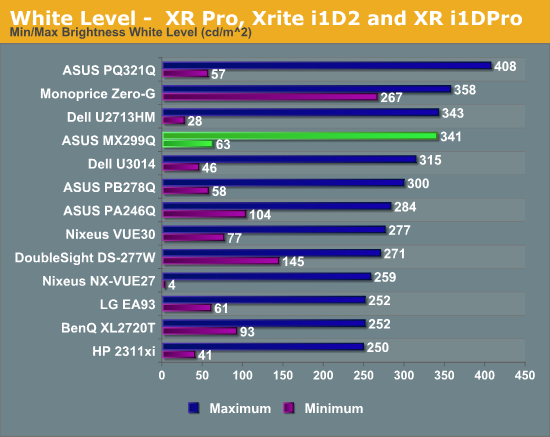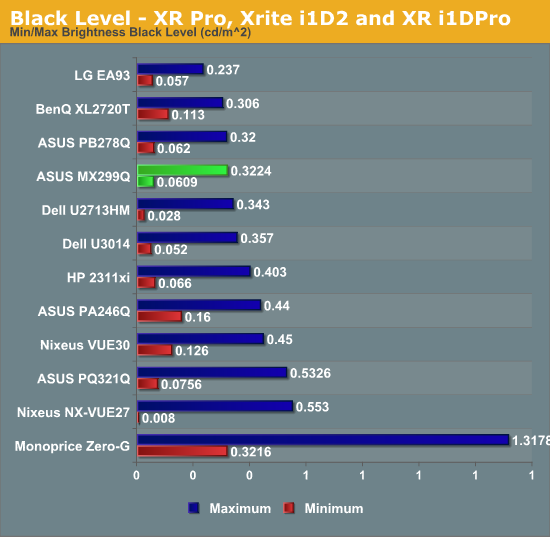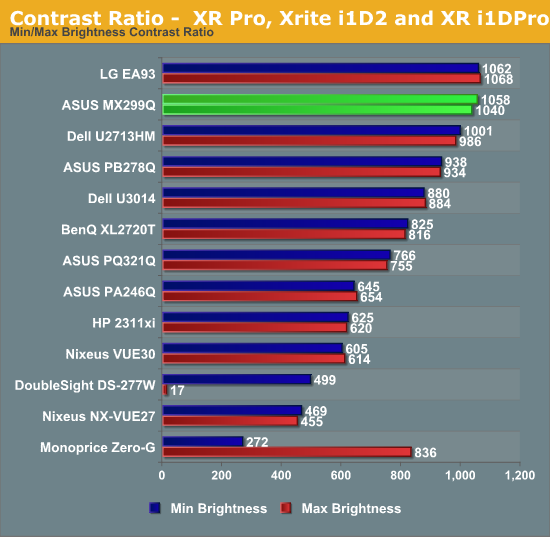ASUS MX299Q Monitor Review
by Chris Heinonen on September 23, 2013 12:00 AM ESTI usually pay little interest to the specs a manufacturer provides for contrast and brightness because they’re so easy to manipulate. Inflated contrast ratios on LED displays come from turning off the backlight and then measuring, as if we work on pure-black screens. Brightness is just as easy to mess with by pushing the panel too far. Everything is tinted and highlights are crushed, but you get a higher brightness reading that might sell. Really everyone is better off to ignore the ratings they see and instead consult with independent reviews.
ASUS manages to split the difference here by under-rating the brightness of the MX299Q but vastly overstating the contrast ratio. ASUS says the MX299Q can produce 300 cd/m^2 of brightness but I managed to produce 341 cd/m^2 from it in my testing. That should be plenty for anyone in regular use, even if you have lots of ambient light. Crank the brightness all the way down and you get 63 cd/m^2, providing you plenty of room in which to find a light level that is appropriate for your work environment.

The black level on the ASUS MX299Q is very good. Even with the backlight at maximum we see a black level of 0.3189 cd/m^2, placing it at the top of the pack. Turn the backlight to the minimum and the light output falls to a miniscule 0.0609 cd/m^2. Both of these are excellent numbers, especially for an IPS panel.

ASUS really got aggressive with their contrast rating of 80,000,000:1 on the MX299Q. The lowest black level any meter can reasonably measure is 0.0001, which would mean a peak white level of 8,000 cd/m^2. I don’t know exactly how bright that is, but I think you’ll be seeing spots or blinded if you looked at a monitor that bright. Needless to say, in practice the MX229Q (and other LCDs) get nowhere near such black levels.
The unfortunate thing is that ASUS has no reason to embellish here. Their actual contrast numbers of 1040:1 and 1058:1 are both excellent and rank among the best IPS displays that have been reviewed.

So ASUS might have been too conservative and too aggressive in their official specs for the MX299Q, but the real-world numbers are very good to see.










44 Comments
View All Comments
dylan522p - Monday, September 23, 2013 - link
Strongly considering getting one of these and putting it in portrait as that would be much better for web content alongside my 2 1080p monitors. Anyone think that would be viable?meacupla - Monday, September 23, 2013 - link
I don't understand how 1080x2560 is better for web content, but I think your main problem would be getting this monitor in that orientation to begin with, since it doesn't look like it has any VESA mounting for an arm that can lift the screen off the table that high.Also, web content is now being made for 1280 width in mind, so wouldn't you be better off with a 2560x1440 or 2560x1600 monitor in portrait mode?
peterfares - Monday, September 23, 2013 - link
You would. These 2560x1080 monitors are basically ONLY good for movies and some games.OscarGoldman - Tuesday, September 24, 2013 - link
Except there's no delivery medium for 21:9 movies. Blu-Ray and streaming services put the image into a 16:9 frame anyway, so the only way you're going to fill a 21:9 frame is zoom into the 16:9 image. That's gonna look wonderful.michaelheath - Tuesday, September 24, 2013 - link
I wonder if you missed the first paragraph of the conclusion:"They’re also fantastic for watching movies on that are shot in scope format."
Which I would presume means Chris actually watched a film in Cinemascope. Blu Ray supports anamorphic widescreen and can map a pixel aspect ratio of 1:1, so the only worry is Netflix.
nathanddrews - Wednesday, September 25, 2013 - link
Blu-ray does NOT support anamorphic encoding. Believe me, I would be ecstatic if that were true! 16:9 is all we get whether the content is scope (2.35/39/40), 1.78, or 4:3, wrapped up in letterbox or pillarbox black bars.An upscale for a typical scope Blu-ray (actual content is ~1920x810) to one of these screens (2560x1080) isn't so terrible, really. That's only a 33% upscale. With a good scaler or scaler software, it should look fine... but does anyone really care about black bars so much that they would buy this screen?
I would buy this for gaming and that's about it, but only if it did 120Hz. Seriously, WhenTF are we going to get more 120Hz native displays?
RocketChild - Monday, September 23, 2013 - link
Asus's other 29" model like this one has VESA mounts. Model PB298QJlHADJOE - Monday, September 23, 2013 - link
longcat. 'nuff said.DanNeely - Monday, September 23, 2013 - link
I've rotated my 2560x1600 monitor a few times. It's too tall. Even with the stand at minimum the top of the screen was too high to look at without tilting my head. If you want a monitor for portrait use stick to a 20 or 22" model.spacecadet34 - Monday, September 23, 2013 - link
You don't need this tall a monitor to do what you want; I'm currently running a triple monitor setup: two 1080P's and one (rotated) Dell @ 1200x1920. Thanks to the "keyhole problem" (http://www.aristeia.com/TKP/), virtually *every* website works better in a vertical orientation. Just make sure the rotated display is an IPS, S-PVA, or similar panel that gives decent viewing angles. A TN panel would look horrible as you move your head side-to-side. Once you get used to this setup you'll never go back, unless you're into gaming.